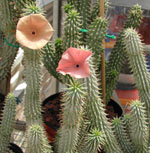
The pure Hoodia that contains appetite suppressant qualities is only grown in one specific region in South Africa. If the Hoodia is from China, USA or any other part of the world and is not accompanied by a South African Government Certificate of Authenticity, the product is inferior and ineffective. Pure Hoodia is 100% All Natural. Hoodia is not a drug. If you buy the right kind it will work. You will eat less, feel full, not be hungry as often, and lose weight. Every clinical case has shown people have been able to reduce their calorie intake by 900 to 1,100 calories daily. This is enough for most people to lose a pound every three-four days. The Hoodia Gordonii plant originated in the southwestern part of Africa and grows best in the semi-arid areas of South Africa primarily the Kalahari. In its native habitat it is extremely difficulty to identify because it looks similar to succulents of the same family of which there are many. Only an experienced botanist or as the case in South Africa with Hoodia Gordonii a San people can identify the plant prior to it's blooming. Scientists at the South African Center for Scientific and Industrial Research were the first to successfully prove that Hoodia contains a miracle molecule that suppresses the appetite. Later, a human clinical trial was conducted by scientists in Leicester England. A group of morbidly obese men and women participated. Half the group were given Hoodia and half were given a placebo. At the end of 15 days, the group on Hoodia had reduced their food intake by 1000 calories a day. Given the average daily diet is around 2200 calories, this was a stunning success. As far as scientists know, there are no negative side-effects. The local san, whose ancestors have been using the plant for thousands of years, claim that there are no negative side effects. So Hoodia can be used in conjunction with prescription medications.
read more...
|